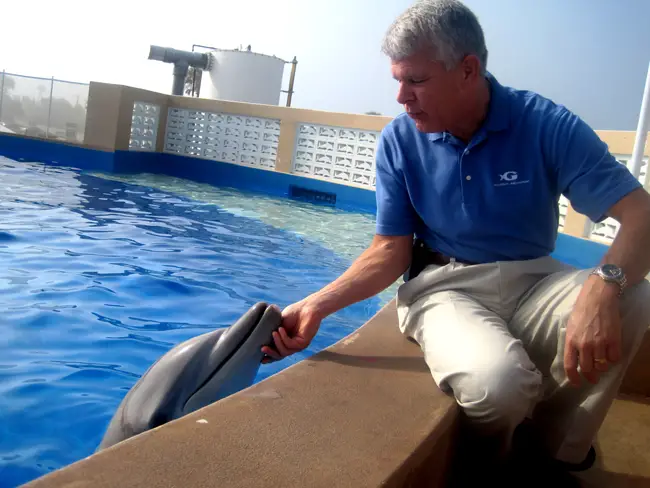
There’s a bit of a drum-roll feel in Marineland these days, with no sense yet of when and to what extent the attraction will change. But its new owners are drizzling hints.
The nonprofit Georgia Aquarium bought Marineland’s 5 acre oceanfront dolphin attraction just before the New Year for $5.7 million. The purchase of the 73-year-old aquatic park came after nearly three years of a joint venture between the aquarium and the Dolphin Conservation Field Station at Marineland. The center studies marine animals off the coast of Georgia and Northeast Florida and rescues and rehabilitates stranded ones.
Click On:
- Georgia Aquarium Buys Marineland’s Dolphin Attraction and Takes It Off the Tax Rolls
- How Marineland Got Public Dollars To Build a (Mostly) Private Marina
- Marineland’s John Hankinson Appointed Director of Obama’s Gulf Recovery Task Force
Atlanta’s Georgia Aquarium President and Chief Operating Officer David Kimmel, who was in Marineland last week, said the Atlanta aquarium decided to make Marineland its first facility acquisition to expand its dolphin rescue programs due to its great access to the ocean and unique history. “Becoming one is natural for us,” Kimmel said. “The plan is to continue to enhance what is currently Marineland.”
Details on the timetable for the expansion were not provided.
Marineland was founded in 1938 for movie studios to film underwater sequences and turned into a theme park in the 1950s. The aquatic operation there has since become a leader in the study of dolphin conservation. But it’s been struggling to draw tourists. Kimmel said his operation intends to use the name of the Georgia Aquarium to reintroduce the public to Marineland. “People don’t know that Marineland is open. People need to come here and see it.”
The name change may add some confusion to an already confusing set-up: Marineland Mayor Jim Netherton irascibly tells every reporter—and anyone else who’ll listen—that Marineland is the name of his town, not the attraction. Not anymore, anyway. The attraction is—was—officially called the Dolphin Conservation Center at Marineland. A mouthful, to be sure, making it easier to simply say: Marineland. The town, at any rate, isn’t much of one: it has less than 10 official residents, and its identity would be nonexistent without the attraction, or future, slightly grandiose plans that have yet to gel. The marriage between town and attraction remains, so far, the town’s best hope for survival, even though the attraction, by going non-profit, is reducing the town’s income considerably.
According to Kimmel this is a new beginning for the Georgia Aquarium. “We have four manta rays at Georgia Aquarium and three of them were caught off the coast of Marineland,” Kimmel said. “This has become a hub for us to go into the Atlantic.”
This year, the Goergia Aquarium will be making some major investments in the infrastructure at Marineland, such as replacing the water systems and electrical items. “Our animals will notice a huge difference.”
Watch Charlotte Marten’s Special Report on Marineland[media id=164 width=400 height=300]
Carey Rountree, marketing vice president for the organization, says the aquarium is planning to roll out an advertising campaign this spring that will focus on a rebranding of Marineland “from a visitation perspective,” he said. “A new name, it will still be Marineland, but there will be a new attachment.”
Netherton, mayor of Marineland since 1995, said he’s not sure if the change in ownership will have any impact on the town, but he is quite sure the aquarium is going to do something exciting with it. “I think it will be a mix of tourism, education, citizen support, volunteerism and various types of community involvement.”
Sheryl Marmo, owner of Ocean Aire Café, located just outside the dolphin attraction, said she is delighted that the aquarium took over. “They are going to help Marineland grow and expand,” she said. “Anyone who knows what the Georgia Aquarium is doing thinks it’s terrific.”
The Marineland attraction transitioned from a for-profit to a nonprofit under the umbrella of the Atlanta-based attraction. As a nonprofit, all donations are tax deductible, “so it’s a great opportunity,” Kimmel, the company president, said. “We have a mission and we are going to continue our mission.”
But with the dolphin attraction taken off the tax roll, the 150-acre town will hurt. The nonprofit status will remove more than $5 million worth of taxable property from the tax roll, almost half of the $11 million total property values in Marineland, Flagler County Appraiser Jay Gardner said. “This is a unique situation. The size of Marineland allowed something like this to happen,“ Gardner said. “Half their tax roll just disappeared.”
Garner said that financially the town of Marineland should be ok. “They have a lot of room to raise the millage rate. They can acquire the money to pay their budget.”
Marineland’s tax rate is $3.08 per $1,000 of taxable value but can legally be increased up to $10 per $1,000. The $3.08 rate this year was already an increase over the $1.70 per $1,000 of the previous year, though those who felt the effects of the increase are few. Ironically, one of the major taxpayers in town in Jim Jacoby, the former owner of the attraction—and a still an owner of sizeable property in town, and a member of the Georgia Aquarium board.
Netherton estimates the town will have to double its tax rate to help fund its nearly $50,000 a year budget. The Marineland mayor is not worried about the town’s financial future.”As long as we don’t lose too much more property off the property taxes we should have enough to keep our finances going. We need very little,” he said. “I am less worried about not having money than I am about not having people in this town for the future.”
The most expensive item on the budget is the $12,000 a year electric bill from Florida Power & Light for the streetlights along State Road A1A, Netherton said. “The attorney is by far the most expensive employee.”
Today, dolphins outnumber residents in town, 12 to 10. There’s just one other property tax payer in town, beside Jacoby: the former Centex Properties, now Pulte Homes.
Jacoby has always planned to build a walkable town center mixing commercial and residential properties. Pulte Homes still has designs of building a string of residential properties on the west side of A1A, though for now there’s no activity on either front. “Unfortunately the economy fell off the cliff and they decided to wait with building residential properties,” Netherton said. “It’s just a matter of when they have the money to start building.”
According to the mayor, the town has the money to complete a planned commercial marina on the Intracoastal Waterway—thanks, in large part, to public subsidies from other agencies. “The main waterline has already been put in place…we hope the Marina to be finished this summer,” he said. “It will add some vibrancy and life to the town while we are waiting for the economy to turn around.”
The town received $200,000 from the Florida Inland Navigation District, $150,000 from the Tourist Development Council and will probably put in another $50,000 to $ 150,000 of its own money to get the project completed.
Kimmel said the aquarium wants to build on the success that’s already been accomplished at Marineland. “You never know what we will end up doing here,” he said. “We are here for the long haul. There is nothing that’s off the table for us right now.”































Leave a Reply